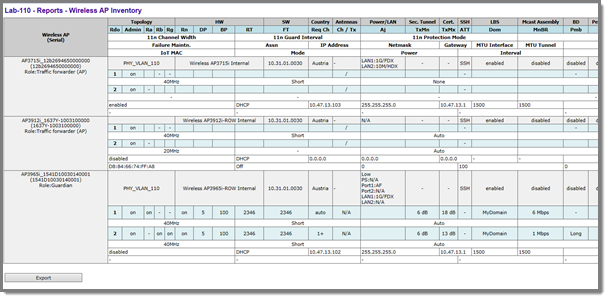
Note
All AP Inventory reports open in a new browser window.
Note
If you open only automatically refreshed reports, the Web management session timer will not be updated or reset. Your session will eventually time out.The following is an example of the Wireless AP Inventory report:

AP Inventory Report Columns lists the column names and abbreviations found in the AP Inventory report:
AP Inventory Report Columns
| Column Name | Description |
|---|---|
| Wireless AP (Serial) | Includes AP type, AP name, serial number, and role (including role type) |
| Topology | Ethernet port and associated IP address of the interface on the controller through which the AP communicates. |
| HW | Hardware version of the AP. |
| SW | Software version executing on the AP. |
| Country | Country in which the AP is deployed |
| Antennas | Antennas used |
| Power Status | Indicates ports on the AP39xx with low power status. Feature available for AP39xx only. |
| Sec. Tunnel | Secure tunnel mode |
| Cert. | AP certification (enabled or disabled) |
| SSH | SSH access (enabled or disabled) |
| LBS | Location-based service (enabled or disabled) |
| Mcast Assembly | Multicast Assembly (enabled or disabled) |
| BD | Broadcast disassociation (enabled or disabled). |
| Persistence | Enabled or disabled |
| P/To | Poll timeout. If polling is enabled, a numeric value. |
| P/I | Poll interval. If polling is enabled, a numeric value. |
| Wired MAC | The physical address of the AP's wired Ethernet interface. |
| Description | As defined on the AP Properties screen. |
| Rdo | Radios: 1 or 2. |
| Ra | 802.11a radio. The data entry for an AP indicates whether the a radio is on or off. |
| Rb | 802.11b protocol enabled. Possible values are on or off. |
| Rg | 802.11g protocol enabled. Possible values are on or off. |
| Rn | 802.11n protocol enabled. Possible values are on or off. |
| DP | DTIM period |
| BP | Beacon Period |
| RT | RTS Threshold |
| FT | Fragmentation Threshold |
| Req Ch | Last requested channel |
| Ch / Tx | Current channel Tx power level |
| Aj | Auto Tx Power Ctrl Adjust when ATPC is enabled |
| TxMn | Minimum Tx power, in decibels |
| TxMx | Maximum Tx power, in decibels |
| ATT | Attenuation for APs that support professional antenna installation. |
| Dom | RF domain |
| MnBR | Minimum Basic Rate (For more information, see the Wireless AP radio configuration tabs.) |
| Pmb | Preamble (long, short) |
| PM | Protection Mode |
| PR | Protection Rate |
| PT | Protection Type |
| VNS Name: MAC | Also called BSSID, this is the MAC address of a (virtual) wireless interface on which the AP serves a BSS/VNS. There could be 8 per radio. |
| 11n Channel Width | 20MHz, 40MHz, or auto |
| 11n Guard Interval | If 11n Channel Width is 40MHz, long or short |
| 11n Channel Bonding | Enabled only if 11n Channel Width is 40MHz |
| 11n Protection Mode | Protects high throughput transmissions on primary channels from non-11n APs and clients. Enabled or disabled. |
| Failure Maintn. | Maintain MU sessions on the Wireless AP when the AP loses the connection to the controller. |
| Assn | Assignment (address assignment method) |
| IP Address | Wireless AP's IP address if statically configured (same as the Static Values button on the AP Static Configuration screen). |
| Netmask | If the AP's IP address is configured statically, the net mask that is statically configured for the AP. |
| Gateway | If the AP's IP address is configured statically, the IP address of the gateway router that the AP will use. |
| MTU Interface | MTU Interface (enabled or disabled) |
| MTU Tunnel | MTU Tunnel value |
| TLS | 802.1x EAP-TLS authentication configuration |
| PEAP | 802.1x PEAP authentication configuration |
| EWC Search List | The list of IP addresses that the AP is configured to try to connect to in the event that the current connection to the controller is lost. |
| IoT MAC | MAC address of the IoT hardware. |
| Mode | Indicates the image type for the IoT hardware. Valid values are: Bluetooth or Thread. Bluetooth is the default. |
| Power | Indicates the received RSSI for the beacon application. Currently fixed. Valid values are: Min.-127dBm, Max. 127dBm, Default. -45dBm. |
| Interval | The advertising interval for the iBeacon application. Valid values are: Min (100ms) and Max (10240ms). The default value is Min (100ms). |
| Major | Identifies a subset of beacons within the larger set. Used to more precisely pinpoint beacon location, and therefore MU location. This value could represent a venue specific attribute, such as a specific store or wing in a building. Valid values are 0 to 65635. |
| Minor | Identifies an individual beacon. Used to more precisely pinpoint beacon location, and therefore MU location. This value complements the UUID and Major values to provide more granular identification of a specific location, such as a particular shelf, door-way, item. Valid values are 0 to 65635. |
| Available for Export Only: | |
| UUID Beacon | Used to differentiate a large group of related beacons. A company can have a network of beacons with the same UUID. A smart phone app can identify the beacons coming from that company. |
| Location of AP XY | Map coordinates. Used in conjunction with a site map. (Top left corner of the map is considered 0,0.) |